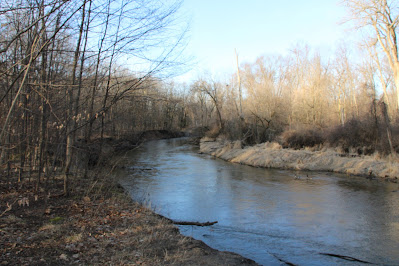The early morning sky at Forest Hill Nature Area is sunny with temperatures hovering around freezing, as I begin hiking through a field of tall Switch Grass while listening to noisy Canada Geese. After watching a pair of Mallards fly over as the hen calls out, I come to the edge of one of the wetlands to see some much-needed water has returned after last year’s drought. Soon, I come upon a dying White Birch tree whose trunk shows a fungal growth called a Birch Conk. This fungus was carried by "Ötzi the Iceman" and may have been used as a laxative to expel whipworm. Ötzi the Iceman, a naturally mummified man from the Copper Age, was discovered in the Alps in 1991, and his well-preserved remains offer insights into the lives and deaths of people from 5,300 years ago. Making my way to another wetland, I pause to hear the call of a Red-bellied Woodpecker along with the drumming sound of another woodpecker. Up ahead, the song of an American Robin catches my attention before I spot it high in an Ash tree. Moving past another wetland, I look up to see and hear only male Redwing Blackbirds and realize that females have not yet returned to begin breeding and nesting. Up ahead, I spot willow branches displaying white, fuzzy nubs. Because these nubs resemble furry, cat paws, the trees are called pussy willows. These nubs are actually flowers just before they fully bloom. The soft fuzzy coating of hairs acts as insulation to protect them from cold temperatures. Even in full bloom, willow flowers hardly look like flowers at all (stock photo). Such flowers are called catkins, also named for cats, in this case for their tails (from the old Dutch word for kitten(katteken). Hiking over to a large pond, I gaze out on the water and can barely make out a mating pair of Common Mergansers, as the male shows off his white breast. They most likely are stopping to rest and feed before proceeding north to their breeding grounds in the boreal forests of Canada and Alaska. The word “merganser” comes from the Latin and roughly translates to “plunging goose”—a good name for this very large diving duck. Circling the pond, I look up at leafless branches of a Green Ash tree displaying brown galls of the male flowers. Microscopic mites (stock photo) feed and lay eggs on bud scales resulting in disfigurement of the flowers and formation of galls. Near the car, I look high overhead to observe a Red Maple tree with hanging clusters of bright red flower buds ready to bloom. Most of these trees are either male or female displaying only male or female flowers. In this case, the flowers are female.
March makes its final stand
Deep in a cattail marsh
Pond won’t give up ice
Weather remains harsh
Amid barren trees
Sheltered from a windy chill
Patches of melting snow
Vestiges of winter still
From a leafless perch
Welcomed sound is heard
Hail, harbinger of spring!
Hail, redwing blackbird
D. DeGraaf




